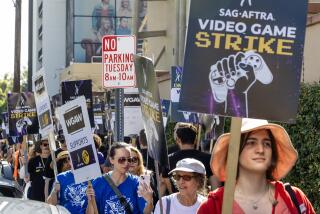The Devil’s in the Details of Actors’ Deal
- Share via
Negotiators for actors and studios returned to the bargaining table Sunday, focusing their negotiations on payments for work appearing on cable TV as they worked on a new three-year deal.
Sources described the talks as in the “horse trading” stage, involving last-minute proposals. But they added that the sides were within reach of a deal, predicting that tying up loose ends and agreeing on contract language likely would extend well into the night.
The old TV and film contract expired at midnight Saturday, but both sides downplayed the event, saying they were committed to forging a deal.
Sources said they saw no obstacles that could cause the talks to implode.
“Neither side is going to take a strike over these issues,” one source close to the talks said.
Negotiators resumed their work about 10:30 a.m. Sunday at the industry’s Alliance of Motion Picture and Television Producers headquarters in Encino. After separate strategy sessions, studio negotiators met with representatives of the Screen Actors Guild and the smaller American Federation of Television and Radio Artists, which together represent about 135,000 actors.
Increasing speculation that an announcement was imminent was the presence of SAG President William Daniels, who would undoubtedly be on hand for the announcement of a deal. Daniels left the talks Saturday afternoon to go to Santa Barbara to celebrate his 50th wedding anniversary with his wife, actress Bonnie Bartlett.
As reported earlier, one potential breakthrough plan the two sides were discussing involves putting more money into the pockets of actors when their work is shown on cable TV, while at the same time allowing studios to pay actors under the same formula they do now.
But studio negotiators believe the arrangement is a bit too pricey, and Sunday they were looking for actors to chip away at other parts of the package being offered to at least partly offset the increase.
The plan involves reducing part, or all, of the pension and health contributions that are taken out of the checks actors receive for cable TV work, which would put them under a system similar to one covering directors and writers. Sources said that such a move would give actors about $3 million overall.
What makes that arrangement appealing to studios is that they would still pay actors the current rate--6% of the license fees that cable networks pay when buying the rights to air TV shows. Actors originally wanted the rate raised to 7.5%. But studios are loath to increase it because they would come under pressure to grant a similar increase to directors and writers.
Actors also are expected to make progress in other areas, including increased minimums for TV work, a special increase for TV guest stars, better residuals for Fox network programs and added payments in some cases when shows air in foreign markets.
A new deal would be welcome news for Hollywood, which has been operating under a cloud of strike threats for a year now.
Before the Writers Guild of America sealed its three-year, $41-million deal with studios in early May, it was a commonly held belief that the industry could suffer a one-two strike punch by writers and actors.
Such an occurrence would have shuttered movie and television production and, according to a study commissioned by former Los Angeles Mayor Richard Riordan’s office, could have cost the Southern California economy $6.9 billion in lost income and nearly 82,000 jobs.
Thomas Short, president of the International Alliance of Theatrical Stage Employees, said last week that his members were hit by a “dramatic slowdown” because of uncertainty about the actors’ contract resolution. Short said that employment in the last month was off by as much as 50% among makeup artists, costumers and hairdressers, 40% by set artists and about 30% among set painters.
For many months, Hollywood agents who peddle scripts and literary properties said that strike fears were causing studios to buy fewer projects, but that activity has begun to pick up in the wake of the writers settlement and anticipated actors deal.
The main focus of the current talks has been the so-called middle-class actors who make on average from $30,000 to $70,000 a year. These journeymen actors--who mostly play guest roles on television shows and bit parts in movies--have been struggling because producers are feverishly looking for ways to slash increasing costs.
The first month of negotiations between actors and studio officials, which began May 15, went slowly, with the parties meeting face to face only sporadically. Talks have intensified in the last two weeks, with both sides honing their proposals and zeroing in on crucial issues.
*
Times staff writer Meg James contributed to this story.
More to Read
The biggest entertainment stories
Get our big stories about Hollywood, film, television, music, arts, culture and more right in your inbox as soon as they publish.
You may occasionally receive promotional content from the Los Angeles Times.










